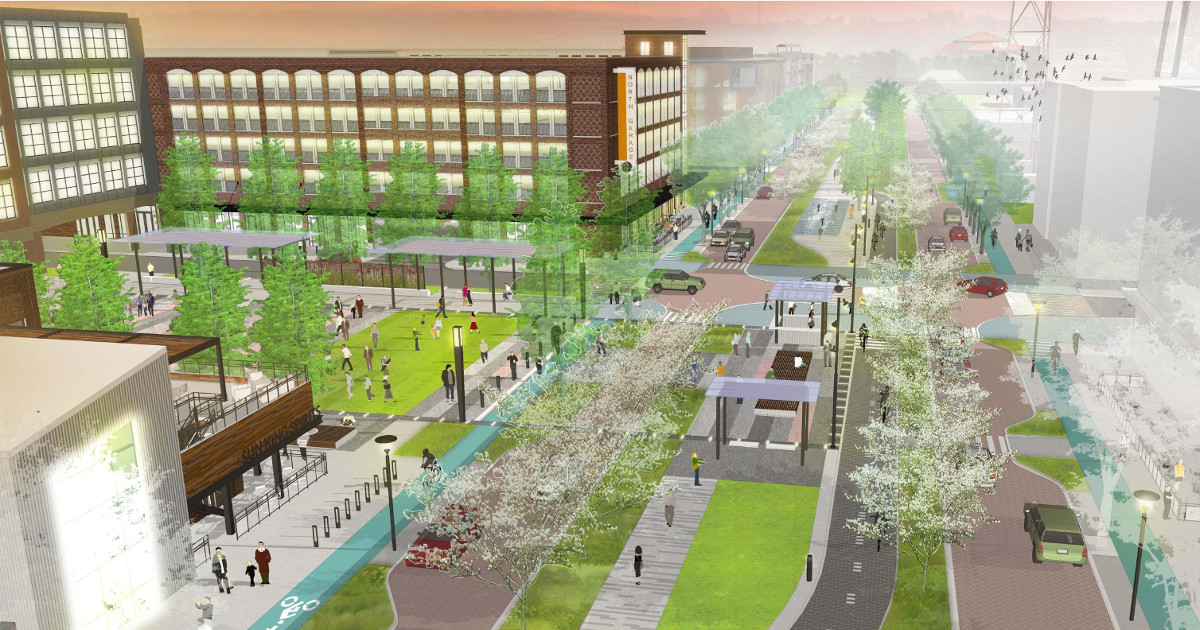You'll sometimes hear that it's almost impossible to make biking truly desirable in American suburbs. Carmel, Indiana, is proving how wrong that is.
The booming city of 90,000, immediately north of Indianapolis but with a distinct and dense downtown of its own, is evidence of the opposite idea: The country's newer, faster-growing cities are where connecting great biking networks has the most potential to transform American life.
As explained in the video above, released Monday by the City of Carmel, the scale of Carmel's investment in better biking since Mayor Jim Brainard first took office in 1996 can almost be hard for an outsider to believe. The city currently has 190 miles of off-street bike paths, with 20 more miles on the way in the next two years.
In January, the City Council agreed to invest $13 million in retrofitting Range Line Road, the main artery through Carmel's city center, for traffic that'll be slower, more pleasant and (the council believes) more lucrative.
"We're moving it from five lanes down to one in each direction, with heavy emphasis on how bikers and walkers can move up and down past our shops and other businesses," Council Member Ron Carter explains in the video, adding that the bike lane design will reflect "the best biking practices around."
"Whenever our arterial streets are reconstructed or we build a new arterial street, we always include multi-use paths on either side," Carter said.

Another $23 million is about to widen part of the Monon Trail, a rails-to-trail multi-use path that runs directly to the Indy Cultural Trail in downtown Indianapolis, into a new Monon Boulevard that will send protected bike lanes through a new commercial district and right past City Hall.
The city has also designated a 101-mile network of paths and lower-traffic side streets as part of the "Carmel Access Bikeway," a sort of pre-neighborhood bikeway network, by spending $60,000 on signs and on-street wayfinding arrows. It sponsors official "bike to school," "bike to work," and "bike to church" days. The city even offers free folding chairs to people who bike to city events.
Is it all working to increase biking? You can see some of the results in the 400 valet-parked bikes at the farmer's market each week -- which also happen to save massive amounts of auto parking space that leaves more room for vendors, fun, and relaxation.
Building bike infrastructure has a cause and effect. Saturday at the Farmers Market. #CarmelIN pic.twitter.com/Bcj1etxNik
— Bruce Kimball (@CarmelBruce) September 18, 2017
"I think in general, Carmel made a very smart decision many years ago to begin updating everything about their city's infrastructure to better suit people and not cars," said Jon Terbush, communications manager for Zagster, a dockless bike-sharing service that launched in Carmel in 2015 with 22 bikes and trikes and has since quadrupled in size there. "What makes Carmel one of our strongest programs is the presence of expansive and well-designed infrastructure, combined with a large (relative to the city's size) bike share that continues to expand in a way that attracts exponentially more riders."
Bruce Campbell, another Carmel council member, said in an interview Tuesday that the city's motivation with all this is simple: economic prosperity.
"We have a different philosophy here: We do not give property tax breaks to corporations," he said. "Instead, we invest in quality of life for all citizens. ... We just had an $80 million public headquarters announced. They were already located here, but all the surrounding communities offered them all sorts of tax breaks. They chose to stay and expand, because it allows them to attract the best employees and keep the best employees. This is a repeating story here."
PlacesForBikes is a PeopleForBikes program to help U.S. communities build better biking, faster. You can follow them on LinkedIn, Twitter or Facebook or sign up for their weekly news digest about building all-ages biking networks.






